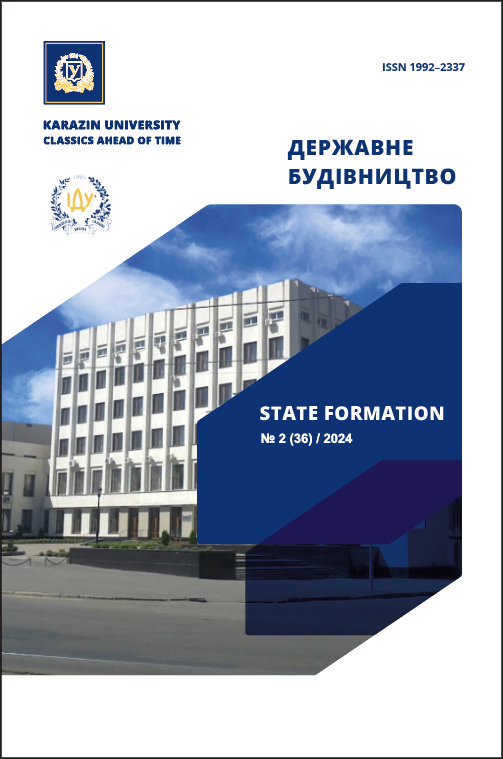Perspective directions of information policy for countering hybrid threats
Abstract
The article comprehensively investigates the current challenges of hybrid threats to the information security of the state and substantiates promising areas for improving information policy to counter these threats in the context of dynamic geopolitical transformations and the rapid development of digital technologies. Based on the analysis of modern scientific concepts, the essence and characteristic features of hybrid influences in the information sphere are revealed, which are based on a synergistic combination of traditional methods of propaganda and disinformation with innovative manipulative technologies and covert forms of intervention with the aim of destabilizing society, controlling mass consciousness and undermining trust in government institutions. The author thoroughly analyzes the key vulnerabilities of the domestic information space to hybrid threats, in particular, he emphasizes the problems of the low level of media literacy of a significant part of the population, the significant spread of Russian disinformation narratives and fakes of an anti-Ukrainian direction in the Ukrainian media environment, institutional weakness and insufficient coordination of actions of state authorities in the field of strategic communications and ensuring information security. Considerable attention is paid to the consideration of the external context of the information war against Ukraine, associated with the geopolitical positioning of our state at the intersection of the interests of various centers of power, which actively use the tools of information and psychological influence to achieve their own goals.
Based on the systematization and critical reflection of advanced foreign experience in the field of countering hybrid threats by means of information policy, key priorities for the development of the relevant tools in Ukraine have been identified. In particular, special emphasis is placed on the feasibility of building a comprehensive system of media education and increasing the digital literacy of citizens based on best European practices, strengthening institutional capacity in the field of strategic communications by creating specialized units for the analysis of disinformation and debunking fakes, establishing an effective partnership of the state with leading social networks and Internet platforms in order to limit the spread of destructive content, as well as strengthening information interaction between the authorities and civil society to increase trust in official sources. The importance of implementing a proactive information policy aimed at forming a positive agenda and establishing national narratives based on democratic values and national interests of Ukraine is argued.
It is substantiated that the effectiveness of countering hybrid threats in the information sphere depends not only on the use of adequate tactical tools, but also on the implementation of systemic democratic reforms aimed at increasing the inclusiveness, transparency and accountability of public administration. Only an organic combination of the information policy development strategy with practical steps aimed at strengthening national identity, consolidating society around a common vision of the future and developing civic activism can ensure the necessary level of resilience to the aggressor’s information operations. At the same time, the need for further comprehensive research into innovative forms and methods of countering hybrid attacks in the conditions of turbulence in global development, taking into account the unique nature of the Ukrainian context, is emphasized.
Downloads
References
Patrikarakos, D. (2017). War in 140 characters: How social media is reshaping conflict in the twenty-first century. New York: Basic Books.
Hoffman, F. (2018). Examining complex forms of conflict: Gray zone and hybrid challenges. PRISM, 7(4), 30–47. URL: https://cco.ndu.edu/News/Article/1680696/examining-complex-forms-of-conflict-gray-zone-and-hybrid-challenges/
Lanoszka, A. (2016). Russian hybrid warfare and extended deterrence in eastern Europe. International Affairs, 92(1), 175–195. DOI: https://doi.org/10.1111/1468-2346.12509
Renz, B. (2016). Russia and ‘hybrid warfare’. Contemporary Politics, 22(3), 283–300. DOI: https://doi.org/10.1080/13569775.2016.1201316
Hellman, M., & Wagnsson, C. (2017). How can European states respond to Russian information warfare? An analytical framework. European Security, 26(2), 153–170. DOI: https://doi.org/10.1080/09662839.2017.1294162
Paul, C., & Matthews, M. (2016). The Russian "firehose of falsehood" propaganda model. Santa Monica, CA: RAND Corporation. URL: https://www.rand.org/pubs/perspectives/
PE198.html
Pomerantsev, P. (2015). How to beat the Kremlin’s propaganda machine. World Affairs, 177(6), 36–42. URL: https://www.jstor.org/stable/43555279
Annala, M. (2018). Responding to hybrid threats: The EU’s resilience agenda. CSS Analyses in Security Policy, 233, 1–4. URL: https://css.ethz.ch/content/dam/ethz/special-interest/gess/cis/center-for-securities-studies/pdfs/CSSAnalyse233-EN.pdf
Fiott, D., & Parkes, R. (2019). Protecting Europe: The EU’s response to hybrid threats. Paris: EUISS. URL: https://www.iss.europa.eu/content/protecting-europe-eus-response-hybrid-threats
Horbulin, V.P., Vlasiuk, O.S., & Kononenko, S.V. (2017). The world hybrid war: Ukrainian forefront. Kyiv: NISD. [in Ukrainian].
Dubov, D.V. (2016). Strategic communications: problems of conceptualization and practical implementation. Strategic Priorities, 4, 9-23. [in Ukrainian].
Saienko, O.H. (2017). The mechanism of information and psychological influence in a hybrid war. Bulletin of the National Academy for Public Administration under the President of Ukraine. Public Administration Series, 1, 125–132. [in Ukrainian].
Bjola, C., & Pamment, J. (2019). Countering Online Propaganda and Extremism: The Dark Side of Digital Diplomacy. Abingdon: Routledge. DOI: https://doi.org/10.4324/9781351264082
Bârgăoanu, A., & Radu, L. (2018). Fake News or Disinformation 2.0? Some Insights into Romanians’ Digital Behaviour. Romanian Journal of European Affairs, 18(1), 24–38. URL: https://rjea.ier.gov.ro/wp-content/uploads/articole/RJEA_vol.18_no.1_June2018_art.2.pdf
Kapantai, E., Christopoulou, A., Berberidis, C., & Peristeras, V. (2021). A systematic literature review on disinformation: Toward a unified taxonomical framework. New Media & Society, 23(5), 1301–1326. DOI: https://doi.org/10.1177/1461444820959296

